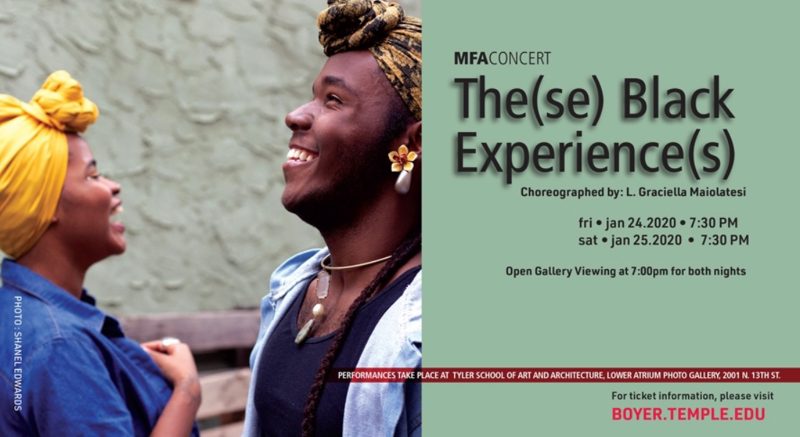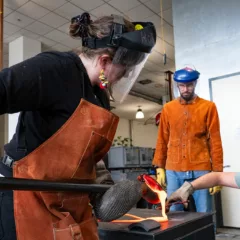
Dancer and curator L. Graciella Maiolatesi’s ambitious and graceful multi-format arts series, The(se) Black Experience(s), where dancers, poets, and performers float, twist, yell and move through space in search of liberation, was an artistic experience that fell both within and outside of the burgeoning conversations around Black/African-diaspora art movements. While the Barnes recently featured 30 Americans, a panoramic cross-section of African American artists featuring Basquiat, Kehinde Wiley and Kara Walker; New York’s queer Black digital collage artist Jacolby Satterwhite’s recent residency at the Fabric Workshop and Museum in Philadelphia and Meg Onli’s exploration of afro-mundane futures in Colored People Time curated at the ICA in 2019– among many other exhibits– have continued the conversation around the Black experience in the arts and how this art is reflective of Black communities in general, with The(se) Black Experience(s) Maiolatesi and company invoked an even deeper idea of Black artistry beyond the usual banal, monolithic conversations. Can there be diversity among people with a shared cultural heritage and experience and what does it look like when that diversity is given ample space?
When asked about the importance of displaying a variety of Black experiences, Maiolatesi stated in an email interview:
“For me, deconstructing the myth that “Black” is a monolithic experience is important because [this deconstruction] simultaneously works to destroy “imposter syndrome,” and therefore how we as Black individuals navigate through the world. As a teenager, I internalized what others said about me: that I wasn’t “Black enough” to identify with the “Black experience.” I felt like an imposter within my own body. It wasn’t until I committed to doing the work to locate and identify my Black experience for myself, that I felt at home in my body.”
Part of that locating is in the form of curating. Maiolatesi assembled a collective of artists, most working within dance, whose work is enthralling and robust. Certainly it may seem that the movement work of Shanel Edwards or Vitche Boule-Ra, artists both recently featured among others in Malachi Lily’s Temple of Sirius project at Da Vinci Art Center (Lily is also a featured artist in The(se) Black Experience(s) ), share similarities, but those similarities belie personal history and the aesthetic principles of each dancer–in this case, Edwards’s work is a treatise on the importance of the revolutionary impact of softness in a queer, Black body and Boule-Ra’s work is often an austere interpretation on the concept of ritual and survival.
When asked about the process of choosing artists and what both separates and links each artist, Maiolatesi said:
“For this specific process I chose people who have been an integral part of my artistic career, who have witnessed me in different walks of life. Interactions with said individuals have very much inspired certain sections of the work. Shanel and I had a whole conversation about locating softness in their personal Black experience, and that conversation was the beginning plans for our guided duet that is now in the show. I am at a point in my career where I am interested in working with people who want to deeply dig into the work. As a tall Queer-Black-Fat-Femme with chronic hip and foot pain, I learned early on that how I do a movement is going to look differently than someone else doing it, and I am interested in these moments of individuality. Again, I aim to celebrate Black narratives, and what I appreciate about all of the performers I am working with currently is the vulnerability and embodied narrative that they each bring.”
For Maiolatesi, the purpose of The(se) Black Experience(s) was to provide safe, improvisational space for Black artists. The event also featured dancers Quaanzale Thompson, Sophiann Moore, Julian Darden, and Ashley Davis as well as visual art from Afaq, Edwards and Lily. The event premiered on January 24 and 25 at the Tyler School of Art on Temple’s campus. This locality ultimately contributed to a more personalized, intimate continuation of the myriad Black experiences within art globally, with the city of Philadelphia itself acting as a nexus point for such conversations. “Philadelphia has served as a catalyst for my identity, creative process, and movement company (Femme Noire Movement Collective),” Maiolatesi explained. “While I can only speak from my own experience as a Queer-Black-Femme, I think Philly attracts Black and LGBTQIA+ artists because it provides a raw honesty that I have not been able to locate in other places. I have been an artist since I was a kid, but Philadelphia is where I honed in on my own creative praxis, beginning to question concepts of performance and how performance plays out into day-to-day experiences of Black people.”
The(se) Black Experience(s) premiered on January 24th & 25th, 2020, at 7:30pm at the Tyler School of Art and Architecture.










